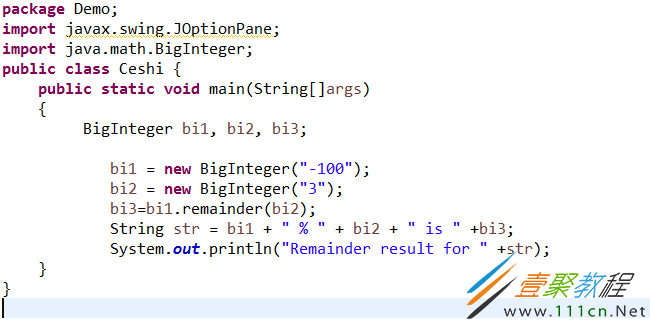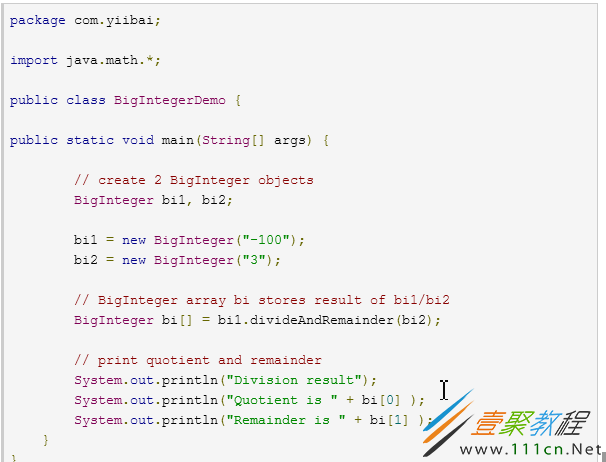使用BigInteger实现除法取余代码示例
本篇文章小编给大家分享一下使用BigInteger实现除法取余代码示例,文章代码介绍的很详细,小编觉得挺不错的,现在分享给大家供大家参考,有需要的小伙伴们可以来看看。
BigInteger 除法取余
1、BigInteger是什么?
Java中,整形的最大范围是64位的long型整数。但是如果我们使用的整数超过了64位呢?这时候就用到了BigInteger。BigInteger内部使用int[]数组来存储足够大的整数。
2、BigInteger实现除法取余
public class BigIntTest {
public static void main(String[] args) {
BigInteger bigInteger = new BigInteger("45615146541561");
BigInteger bigInteger2 = new BigInteger("6541315");
BigInteger[] resBigIntegers = bigInteger.divideAndRemainder(bigInteger2);
System.out.println("两数相除,整除结果为:" + resBigIntegers[0] +
",余数为:" + resBigIntegers[1]);
}
}
运行结果:
BigInteger简单使用及方法总结
BigInteger 可以用来解决数据的溢出问题!
下面我总结几种关于BigInteger的常用用法:
1、probablePrime和nextprobablePrime。(判断质数,并返回)
BigInteger.probablePrime(int x);
返回有可能是素数(质数),具有指定长度的正数BigInteger,返回可能是合数的概率不超过2的负100次方,
BigInteger.nextprobablePrime(int x)
返回大于此BigInteger的有可能是素数(质数),具有指定长度的正数BigInteger,返回可能是合数的概率不超过2的负100次方
2、valueOf()(对数据初始化)
BigInteger valueOf(long val)
用法如下:
3、四则运算
(add(加)。subtract(减)。multiply(乘)。divide(除))
调用方式如上图,可以重复调用
4、remainder(取余)
返回其值为取余后的BigInteger类型的值,例子如下
调用的时候要保证数据是BigInteger类型的,可以用初始化(valueOf)或者new一个。
5、divideAndRemainder(先除后取余,结果分别存在数组中)
相关文章
精彩推荐
-
 下载
下载猪笼城寨手游
模拟经营 猪笼城寨手游猪笼城寨游戏是非常好玩的一款模拟经营类型的手游,在这里玩家们
-
 下载
下载商道高手vivo版本
模拟经营 商道高手vivo版本商道高手vivo版是一款商战题材的模拟经营手游,游戏画面精美
-
 下载
下载我在大清当皇帝手游
模拟经营 我在大清当皇帝手游我在大清当皇帝手游是一款以清代为历史的模拟类手游,相信玩家们
-
 下载
下载解忧小村落最新版2024
模拟经营 解忧小村落最新版2024解忧小村落游戏是非常好玩的一款休闲放置经营类型的手游,在这里
-
 下载
下载洋果子店rose2中文版
模拟经营 洋果子店rose2中文版洋果子店rose2中文版是一款非常好玩的模拟经营手游,精美的



















